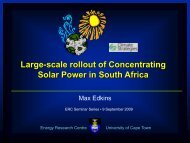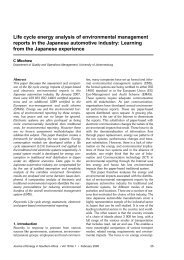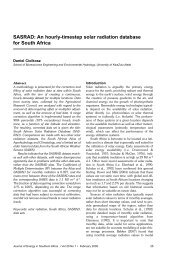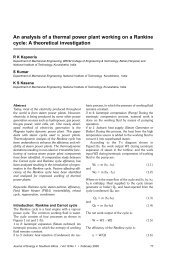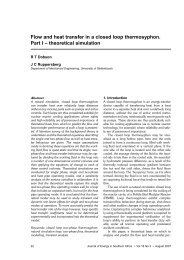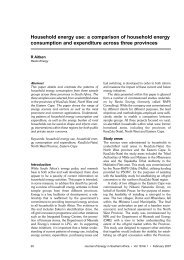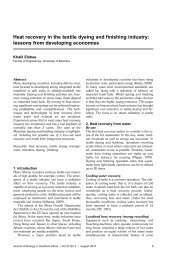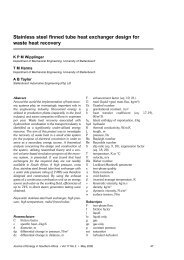Solar electrification by the concession approach in rural Limpopo ...
Solar electrification by the concession approach in rural Limpopo ...
Solar electrification by the concession approach in rural Limpopo ...
You also want an ePaper? Increase the reach of your titles
YUMPU automatically turns print PDFs into web optimized ePapers that Google loves.
<strong>Solar</strong> <strong>electrification</strong> <strong>by</strong> <strong>the</strong> <strong>concession</strong> <strong>approach</strong> <strong>in</strong> <strong>rural</strong> <strong>Limpopo</strong> prov<strong>in</strong>ce 31Table 10.2: Monthly expenditure (R) on all fuels <strong>in</strong>clud<strong>in</strong>g electricityn Mean Median SDAll sub-samples 275 93.20 74.00 68.02SHS-owners 120 128.02 92.17 78.04Grid-owners 42 59.10 58.16 27.77Non-electrified households 114 72.90 55.10 60.02When <strong>the</strong> cost of electricity is <strong>in</strong>cluded, <strong>the</strong> energy expenditure for SHS-users still rema<strong>in</strong>s <strong>the</strong>highest, and that for non-electrified households, unchanged, rema<strong>in</strong>s <strong>the</strong> second highest. The relativemagnitudes of <strong>the</strong>se expenditures can be easily compared <strong>in</strong> Figure 10.1 above. The figure also<strong>in</strong>cludes <strong>the</strong> overall mean for comparison, and it is apparent that SHS-users are <strong>the</strong> only sub-sampleabove <strong>the</strong> overall mean.10.2 The proportion of household budget devoted to fuels andelectricityAverage proportion of <strong>in</strong>come spent on all fuels accord<strong>in</strong>g to sub-samplesTable 10.3: Proportion of <strong>in</strong>come spent on all fuels accord<strong>in</strong>g to sub-samplesn Mean Median Std devAll sub-samples 247 8.6% 7.0% 6.3%SHS-owners 115 10.8% 8.3% 7.8%Grid-owners 40 6.1% 4.7% 4.3%Non-electrified households 95 7.6% 6.3% 5.6%When all households are taken <strong>in</strong>to account, <strong>the</strong> mean percentage of total <strong>in</strong>come spent on energy is8.6%. SHS-users top <strong>the</strong> list for percentage of <strong>in</strong>come spent on energy, with a figure of 10.8% whilegrid-users spend <strong>the</strong> least, 6.1%. Thus, despite <strong>the</strong>ir higher <strong>in</strong>comes relative to <strong>the</strong> o<strong>the</strong>r subsamples,<strong>the</strong> high energy expenditure of SHS-users means <strong>the</strong>y still spend a larger proportion of <strong>the</strong>ir<strong>in</strong>come on energy.The fact that <strong>the</strong> poorest still spend a larger proportion of <strong>the</strong>ir <strong>in</strong>come on energy is not alteredhowever, as Figure 10.2 shows. It can be seen that households with <strong>in</strong>comes above R1 000 permonth do not spend more than 20% of <strong>the</strong>ir <strong>in</strong>come on energy (most are below 10%), those earn<strong>in</strong>gbelow this amount can spend far higher percentages on energy. Households earn<strong>in</strong>g above R3000per month spend well below 10% of <strong>the</strong>ir <strong>in</strong>come on energy.% of <strong>in</strong>come spent on energy ________70%60%50%40%30%20%10%0%- 1000 2000 3000 4000 5000 6000Total monthly <strong>in</strong>comeTable 10.2: Scatter plot of <strong>in</strong>come vs expenditure for all households <strong>in</strong> all sub-samplesENERGY RESEARCH CENTRE




